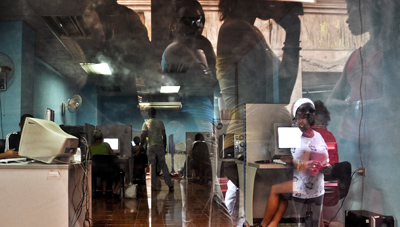There is a popular expression in Cuba that is synonymous with difficulty and crisis. When you want to indicate that someone is doing badly economically, it is sufficient to say that he is “eating a cable.” Street humor has identified the act of chewing and swallowing a bundle of wires with scarcity and material want. The parable has gained strength these days in reference to the fiber-optic cable installed between Cuba and Venezuela, which has yet to provide service to Cuban clients despite reports that it is finally functioning.
In 2007, Cuba and Venezuela began working on installation of the Alba-1 submarine cable, named for the Spanish acronym of the Bolivarian Alternative for the Countries of Our America. At the cost of $70 million and after a series of delays, the cable touched ground in Santiago de Cuba in February 2011. However, the island continued to use satellite providers for what little Internet service was available. In the two years since, government media has been silent about the cable, generating rumors of a possible failure due to mismanagement or the diversion of resources.
Three weeks ago, an expert at Renesys, a U.S. firm that analyzes Internet traffic, suggested in his blog that the Alba-1 cable had started showing activity. At first, traffic was detectable in only one direction, but after several days he had confirmed the sending and receiving of data. Doug Madory, a Renesys research engineer, said the Spanish company Telefónica SA had begun to direct Internet traffic to the government-owned Internet service provider ETECSA. Telefónica denied it was supplying routing services for the Alba-1, but confirmed that it was providing other services to ETECSA.
The expert said lower Internet latencies to Cuba could be evidence that the island is using other sources of access in addition to the satellites. “While activation of the Alba-1 could be a good way to improve ETECSA’s links to the Internet, Cuba will probably continue to be unable to provide a wide range of network access,” Madory wrote on Renesys’s website.
According to official statistics, 23 of every 100 inhabitants on the island have access to the Internet. That figure has been heavily criticized and put in doubt by many analysts, who say that the rate includes users of the country’s intranet, where no websites are available that dissent from the regime. Studies have ranked Cuba in last place in Latin America for international Internet connectivity with a rate of only 3 percent, but even that number seems optimistic.
In the two weeks since the first signs of cable activity, there has been no perceptible change in connectivity for users in work or educational centers. Nor, as far as can be proved, has the speed increased in the few Internet cafés that exist in Havana. With prices ranging between 5 and 10 euros (about US$7 to US$13) per hour, hotels continue to offer extremely slow connections to the Internet and many sites are blocked.
The same day the Alba-1 activity was reported, a young man who was waiting outside a crowded Internet café in Old Havana was surprised by the information provided by Renesys. “Now how will they explain why we have to pay so much for an hour of connection?” he asked. The various people waiting their turn for a computer concurred.
The independent journalist Frank Abel Garcia, whose tweets under the handle @FrankAbelCuba are published only via text messages, was skeptical about the news. “I think there is no interest or political will on the part of the government for the people to have Internet access.” In his estimation, if the cable was activated on a massive scale it could be a “strong blow to state propaganda. It would open the eyes of a lot of people in regards to what happens in the world and in our own country.”
The official media, as usual, have been silent, and television programs continue to depict the Internet as a conglomerate of violence, pornography, and false information. But many young people seem excited and anxious about the latest details on the cable that have appeared in the international press. Perhaps the great World Wide Web is closer than it appears.
